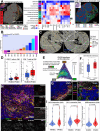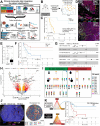This is a preprint.
Spatially organized inflammatory myeloid-CD8+ T cell aggregates linked to Merkel-cell Polyomavirus driven Reorganization of the Tumor Microenvironment
- PMID: 40501860
- PMCID: PMC12157451
- DOI: 10.1101/2025.06.06.657162
Spatially organized inflammatory myeloid-CD8+ T cell aggregates linked to Merkel-cell Polyomavirus driven Reorganization of the Tumor Microenvironment
Abstract
Merkel cell carcinoma (MCC) is an aggressive skin cancer with high propensity for metastasis, caused by Merkel-cell-polyomavirus (MCPyV), or chronic UV-light-exposure. How MCPyV spatially modulates immune responses within the tumor microenvironment and how such are linked to patient outcomes remains unknown. We interrogated the cellular and transcriptional landscapes of 60 MCC-patients using a combination of multiplex proteomics, in-situ RNA-hybridization, and spatially oriented transcriptomics. We identified a spatial co-enrichment of activated CD8+ T-cells and CXCL9+PD-L1+ macrophages at the invasive front of virus-positive MCC. This spatial immune response pattern was conserved in another virus-positive tumor, HPV+ head-and-neck cancer. Importantly, we show that virus-negativity correlated with high risk of metastasis through low CD8+ T-cell infiltration and the enrichment of cancer-associated-fibroblasts at the tumor boundary. By contrast, responses to immune-checkpoint blockade (ICB) were independent of viral-status but correlated with the presence of a B-cell-enriched spatial contexts. Our work is the first to reveal distinct immune-response patterns between virus-positive and virus-negative MCC and their impact on metastasis and ICB-response.
Keywords: Immune-checkpoint blockade; Merkel cell carcinoma; Metastasis; Multiplexed imaging; Systems Immunology; Tumor microenvironment; Tumor virus; head and neck carcinoma; spatial biology; spatial context.
Conflict of interest statement
Competing interests G.P.N., and Y.G., have equity in and are scientific advisory board members of Akoya Biosciences. Akoya Biosciences makes reagents and instruments that are dependent on licenses from Stanford University. Stanford University has been granted US patent 9909167, which covers some aspects of the technology described in this paper. Y.G. and M.H. are scientific advisory board members of CellFormatica Inc, outside of the submitted work.
Figures







References
Publication types
Grants and funding
- R01 CA229529/CA/NCI NIH HHS/United States
- U54 HG012723/HG/NHGRI NIH HHS/United States
- U19 AI100627/AI/NIAID NIH HHS/United States
- U01 AI101984/AI/NIAID NIH HHS/United States
- U54 HG010426/HG/NHGRI NIH HHS/United States
- U2C CA233195/CA/NCI NIH HHS/United States
- U19 AI135976/AI/NIAID NIH HHS/United States
- P01 AI131374/AI/NIAID NIH HHS/United States
- U19 AI057229/AI/NIAID NIH HHS/United States
- U2C CA233238/CA/NCI NIH HHS/United States
- U01 AI140498/AI/NIAID NIH HHS/United States
- U54 CA209971/CA/NCI NIH HHS/United States
- UH3 DK114937/DK/NIDDK NIH HHS/United States
- P01 HL108797/HL/NHLBI NIH HHS/United States
LinkOut - more resources
Full Text Sources
Research Materials
